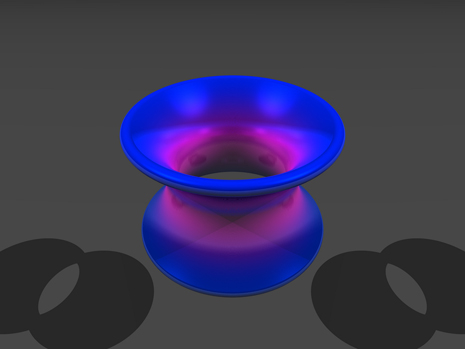6.R: Chapter 6 Review Exercises
( \newcommand{\kernel}{\mathrm{null}\,}\)
True or False? Justify your answer with a proof or a counterexample.
1) The amount of work to pump the water out of a half-full cylinder is half the amount of work to pump the water out of the full cylinder.
- Answer
- False
2) If the force is constant, the amount of work to move an object from x=a to x=b is F(b−a).
3) The disk method can be used in any situation in which the washer method is successful at finding the volume of a solid of revolution.
- Answer
- False
4) If the half-life of seaborgium−266 is 360 ms, then k=ln2360.
For exercises 5 - 8, use the requested method to determine the volume of the solid.
5) The volume that has a base of the ellipse x24+y29=1 and cross-sections of an equilateral triangle perpendicular to the y-axis. Use the method of slicing.
- Answer
- V=32√3units3
6) y=x2−x, from x=1 to x=4, rotated around the y-axis using the washer method
7) x=y2 and x=3y rotated around the y-axis using the washer method
- Answer
- V=162π5units3
8) x=2y2−y3,x=0,and y=0 rotated around the x-axis using cylindrical shells
For exercises 9 - 14, find
a. the area of the region,
b.the volume of the solid when rotated around the x-axis, and
c. the volume of the solid when rotated around the y-axis. Use whichever method seems most appropriate to you.
9) y=x3,x=0,y=0, and x=2
- Answer
- a. A=4 units2
b. V=128π7 units3
c. V=64π5 units3
10) y=x2−x and x=0
11) [T] y=ln(x)+2 and y=x
- Answer
- a. A≈1.949 units2
b. V≈21.952 units3
c. V=≈17.099 units3
12) y=x2 and y=√x
13) y=5+x,y=x2,x=0, and x=1
- Answer
- a. A=316 units2
b. V=452π15 units3
c. V=31π6 units3
14) Below x2+y2=1 and above y=1−x
15) Find the mass of ρ=e−x on a disk centered at the origin with radius 4.
- Answer
- m≈245.282
16) Find the center of mass for ρ=tan2x on x∈(−π4,π4).
17) Find the mass and the center of mass of ρ=1 on the region bounded by y=x5 and y=√x.
- Answer
- Mass: 12,
Center of mass: (1835,911)
For exercises 18 - 19, find the requested arc lengths.
18) The length of x for y=cosh(x) from x=0 to x=2.
19) The length of y for x=3−√y from y=0 to y=4
- Answer
- s=[√17+18ln(33+8√17)] units
For exercises 20 - 21, find the surface area and volume when the given curves are revolved around the specified axis.
20) The shape created by revolving the region between y=4+x,y=3−x,x=0, and x=2 rotated around the y-axis.
21) The loudspeaker created by revolving y=1x from x=1 to x=4 around the x-axis.
- Answer
- Volume: V=3π4 units3
Surface area: A=π(√2−sinh−1(1)+sinh−1(16)−√25716) units2
For exercise 22, consider the Karun-3 dam in Iran. Its shape can be approximated as an isosceles triangle with height 205 m and width 388 m. Assume the current depth of the water is 180 m. The density of water is 1000 kg/m3.
22) Find the total force on the wall of the dam.
23) You are a crime scene investigator attempting to determine the time of death of a victim. It is noon and 45 °F outside and the temperature of the body is 78 °F. You know the cooling constant is k=0.00824 °F/min. When did the victim die, assuming that a human’s temperature is 98 °F?
- Answer
- 11:02 a.m.
For the following exercise, consider the stock market crash in 1929 in the United States. The table lists the Dow Jones industrial average per year leading up to the crash.
| Year after 1920 | Value ($) |
| 1 | 63.90 |
| 3 | 100 |
| 5 | 110 |
| 7 | 160 |
| 9 | 381.17 |
Source: http:/stockcharts.com/freecharts/hi...a19201940.html
24) [T] The best-fit exponential curve to these data is given by y=40.71+1.224x. Why do you think the gains of the market were unsustainable? Use first and second derivatives to help justify your answer. What would this model predict the Dow Jones industrial average to be in 2014 ?
For exercises 25 - 26, consider the catenoid, the only solid of revolution that has a minimal surface, or zero mean curvature. A catenoid in nature can be found when stretching soap between two rings.
25) Find the volume of the catenoid y=cosh(x) from x=−1 to x=1 that is created by rotating this curve around the x-axis, as shown here.

- Answer
- V=π(1+sinh(1)cosh(1)) units3
26) Find surface area of the catenoid y=cosh(x) from x=−1 to x=1 that is created by rotating this curve around the x-axis.

